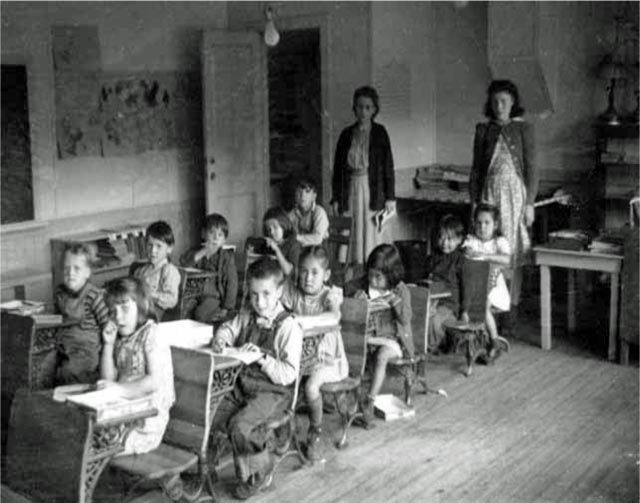Language Loss & Revitalization
Interaction between Alutiiq and other languages has always been a reality for Alutiiq communities, but only in the modern era has it resulted in a reduction of fluent speakers. Alutiiq villagers before Western contact often knew neighboring dialects, and some individuals became experts in farther-flung languages as well as sign language in order to facilitate communication. Upon Russian colonization, Alutiiq language use persisted despite the expectation to learn Russian for interacting with explorers, colonizers, and church officials. This changed upon the sale of Alaska to the United States in 1867.

Children studying at the Ouzinkie School, ca. 1949. Malinda Lamp Collection.
It was during the first 100 years of American rule that the Alutiiq language struggled the most. Although some villagers learned English in addition to Alutiiq and Russian, negative pressure by mission and secular schools taught parents that the Native language would stigmatize their children. Fluent children learned that speaking Alutiiq could result in a ruler to the hand, a soapy rag in the mouth, or other traumatizing punishments. Many children of trilingual parents grew up monolingual, speaking only English in an effort to survive in American society. Today people ask their parents and grandparents why they didn’t pass on the gift of our heritage language. The bitter answer is often that the parents’ love was manipulated by “English only” proponents, who claimed that fluency in a Native language was a detriment to their child’s success.
How many Alutiiq speakers are there today? The exact total is unknown, especially as scholars measure language ability on a scale of fluency ranging from novice to advanced, and ability can vary within one person when measuring understanding versus speaking skills. Generally, fluent speaker counts only identify those with superior language ability. In threatened languages, where no standard method of fluency assessment exists, scholars must sometimes use social rather than scientific tools to measure speaker numbers. For example, they count speakers who are named by other known fluent speakers. The Alutiiq Museum has used phone and small-group Elder polling to develop a fluent speakers list that is added to if existing speakers are identified, and updated when a known fluent speaker passes away.
The Native Peoples and Languages map, produced in 1982 by the Alaska Native Language Center at the University of Alaska Fairbanks, identified 900 speakers (Krauss 1982). By 1994, the number of speakers had dropped by half (Krauss 1994) (Table 1). A 2003 survey of Kodiak Island identified only 45 partially or fully fluent speakers residing in the archipelago (Hegna 2004), although later surveys identified additional Elder speakers living outside of Kodiak, in places like Anchorage, Wasilla, and Washington state. Due to the regular passing of fluent speakers, whose ages average in the mid 70s, estimates of speaker numbers have been difficult to obtain and are often inaccurate. As of January 2012, the Alutiiq Museum estimates the current number of fluent speakers of the Kodiak Alutiiq sub-dialect to be just 45 (Table 2). All Alutiiq dialects show steady decline. Michael Krauss estimated 200 remaining fluent speakers for all Alutiiq dialects in 2007, and Jeff Leer estimated approximately 150 in 2010 (Krauss 2007). It is likely that the total number of remaining speakers of both the Chugach and Koniag dialects is less than 150 in 2012 (Table 1).
Table 1. Estimated Number of fluent Alutiiq/Sugpiaq speakers of all dialects
|
Date |
Speakers |
Source |
|
1982 |
900 |
Krauss 1982—Native Peoples & Languages Map |
|
1994 |
450 |
Krauss 1994—Many Tongues, Ancient Tales |
|
2007 |
200 |
Krauss 2007—Native Languages of Alaska |
|
2010 |
150 |
Leer 2010—Personal Communication |
Table 2. Estimate Number of fluent Kodiak Alutiiq speakers in 2012
|
Speaking Style |
Speakers on Kodiak |
Speakers beyond Kodiak |
All Speakers |
|
Northern Style |
10 |
1 |
11 |
|
Southern Style |
23 |
11 |
34 |
|
All |
33 |
12 |
45 |
Despite this alarming decline, there is hope for the preservation of the Alutiiq language. Since 2002, the Kodiak Island Alutiiq organizations and tribal groups have been conducting Alutiiq language revitalization projects. Language revitalization efforts have developed a small number of new speakers with basic and intermediate levels of fluency, with a few advanced level speakers emerging in the past few years. Language learning resources are working their way into classrooms, preschools, and summer camps. The sounds of Alutiiq, once carefully hidden from the public, are now joyfully shared through public programs like the Alutiiq Word of the Week.
Don’t Miss a Word!
Sign up for our email broadcast and we’ll send you a weekly language lesson and a link to our podcast.
Language Lessons
- Alutiiq – What is in a Name?
- Alutiiq and other Alaskan Languages
- Origins of the Alutiiq Alphabet
- Dialects and Styles of Alutiiq
- Language Loss & Revitalization
- Alutiiq Orthography
- Aapit – Alphabet
- Vowels
- Doubled Vowels & Diphthongs
- Consonants
- Stop Consonants
- Fricative Consonants
- Nasal Consonants
- Softening of Consonants
- Alutiiq Grammar: An Overview
- Pluralization
- Working with Noun Stems
- Working with Verb Stems
- Suffixes and Other Word Endings
- Postbases and Joining
- Alutiiq in Correspondence
- Kodiak Alutiiq Place Names
- Alutiiq Numbers
